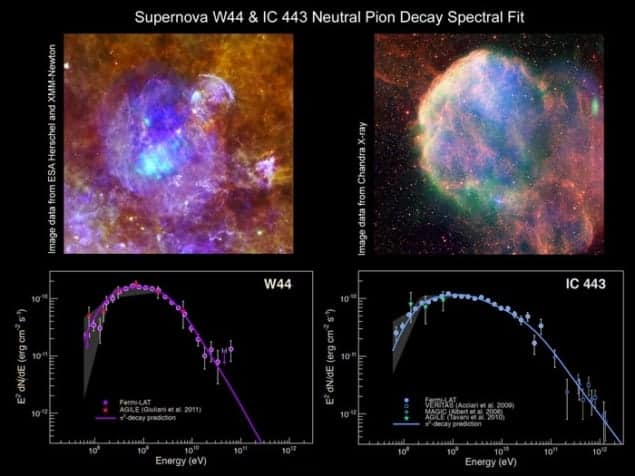
The first direct evidence that galactic cosmic rays are accelerated within supernova remnants has been provided by observations by the Fermi Large Area Telescope collaboration. The results make use of four years of data collected by the telescope observing two supernova remnants – IC 443 and W44 – within our galaxy. The observations fit very neatly with predictions of neutral pion decay.
Galactic cosmic rays – the hypothesis
Cosmic rays are highly energetic particles, mainly protons, whizzing through space, most of which have their origins outside the solar system. A popular explanation of the origins of galactic cosmic rays – those produced within the Milky Way – is that they come from supernova remnants (SNRs), but until now there has been no unambiguous observational evidence linking the two.
When a star goes supernova, its remnants – including strong magnetic fields – can linger for thousands of years. According to the SNR cosmic-ray hypothesis, protons are accelerated by the shock front created in a supernova and then further accelerated by the magnetic fields until they gain enough energy to escape this process and become a newly formed cosmic ray. These energetic protons, the hypothesis claims, sometimes collide with other protons – in interstellar clouds, for example – to produce a neutral pion, which decays almost instantly into two gamma-ray photons.
Observing gamma rays
The 4303 kg Fermi Gamma-ray Space Telescope was launched in June 2008 on a five-year-minimum mission. The Fermi Large Area Telescope (Fermi LAT) is an instrument on board this observatory that uses sophisticated particle detectors to measure the trajectories and energies of incoming photons. Between 4 August 2008 and 16 July 2012, the Fermi LAT collaboration studied the SNRs IC 443 and W44 – which are about 5000 and 10,000 light-years from us, respectively – paying particular attention to gamma rays with sub-GeV (a billion electronvolts) energies. Although gamma rays can have significantly larger energies in some objects, the Fermi LAT focused on a range that would provide data crucial to distinguishing between gamma rays emerging from pion decays and those produced by other means, such as accelerated electrons.
Protons can only be accelerated to a certain level by the SNRs before they are ejected. This places an upper bound on the energies of these protons, which also places limits on the energy of the intermediate pions and subsequent gamma rays. More importantly, though, because the neutral pion is a heavy particle with a mass of 135 MeV (more than 260 times heavier than the electron), the gamma rays into which the pions decay are expected to have a minimum energy – that is, below a certain energy, one expects no gamma rays if they are indeed produced from protons accelerated in SNRs. “That is the smoking-gun signature for gamma-ray emission from the decay of pions, which can only be created by accelerated protons,” says Stefan Funk, a physicist at Stanford University and SLAC National Accelerator Center, and a member of the Fermi LAT collaboration.
Finding the smoking gun
Given the abundance of cosmic rays and the many models that could explain them, Funk and colleagues had to take into account the various backgrounds affecting their data before confirming the source of the observed gamma rays. And they believe they have finally observed the smoking gun.
Referring to the SNR spectra (click on the image above), Funk tells physicsworld.com that “if you look at the data points, you will see that they show the two cut-offs: the high-energy one, which corresponds to the maximum energy to which protons can be accelerated within the SNRs in question, and the low-energy one, which corresponds to the pion-decay cut-off, the minimum energy that the gamma rays receive in the pion decay”. Of course, there are several models that could explain the data, including the possibility that the gamma rays are produced by the acceleration of electrons, but the team was unable to match its data to any of them. “The curve labelled ‘pion-decay’, on the other hand, shows what you expect for gamma rays from protons that decay via the pion, which is very consistent with our data,” explains Funk. The significances of these observations are 19σ and 21σ for IC 443 and W44, respectively.
“This paper offers very important information that can shed light on the characteristics of supernova remnants from the point of view of cosmic-ray production,” says Jozef Masarik, of Comenius University in Bratislava, who was not involved in the research. “Understanding of the origin of cosmic rays can even contribute to the verification or dismissal of some beyond-the-Standard-Model theories.”
Cosmic rays were first observed by Victor Hess in the early 20th century. A century later, this result from Fermi LAT is the first to confirm the supernova origin of galactic cosmic rays. What the researchers cannot yet say is whether supernova remnants are the only source of these mysterious particles.
The research is published in Science.



